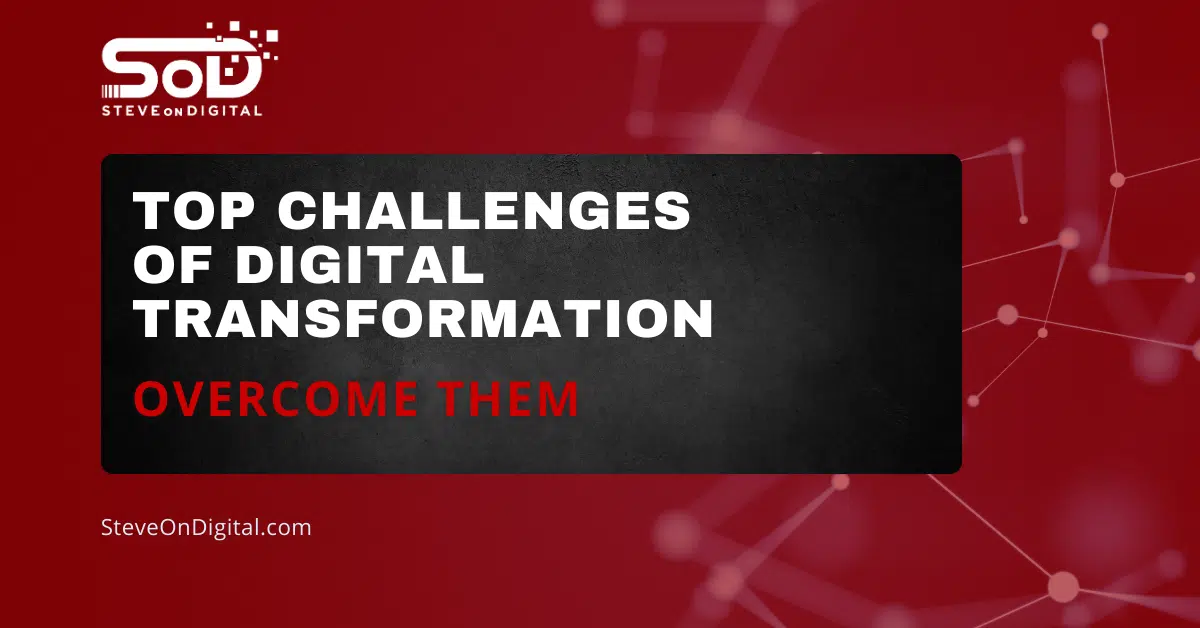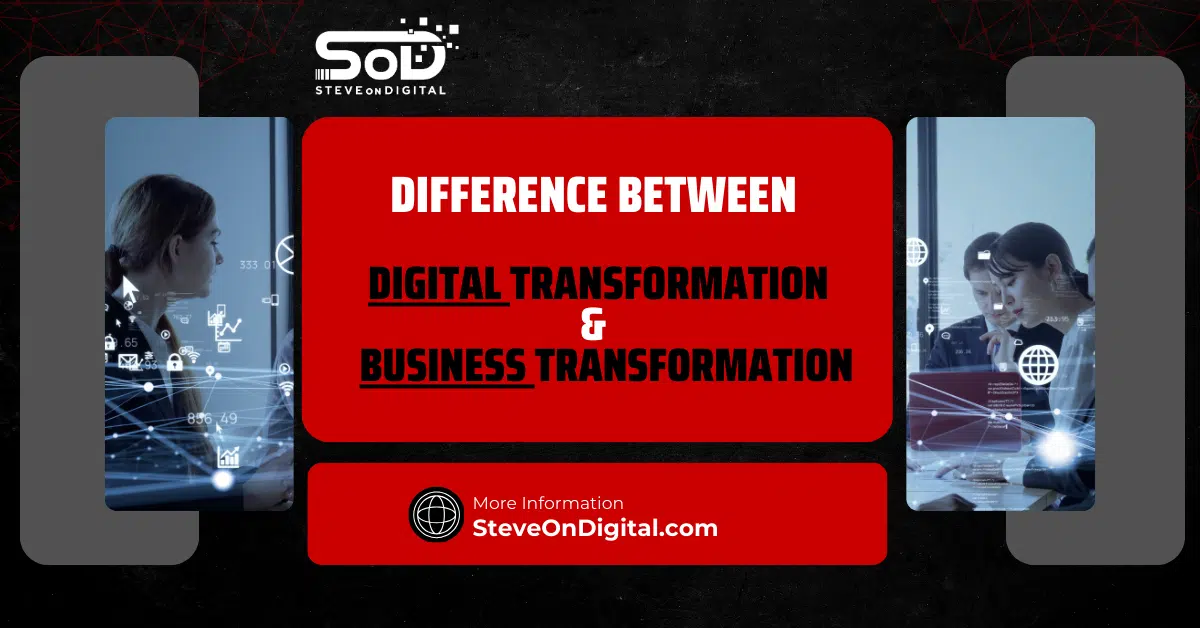Digital transformation means using new digital tools to change how a business works, its culture, and how it interacts with customers. This transformation can face many challenges, including legacy systems, change management issues, and a digital skills gap. These obstacles can slow down progress and make it difficult to fully leverage the digital processes and technologies.
In today’s competitive environment, with digital transformation difficult, understanding these challenges is crucial for success. Addressing these issues can help businesses streamline operations, enhance customer experiences, and stay ahead in the market. Through careful planning and strategy, companies can overcome these hurdles and achieve a successful digital transformation.
I’m Steve, a digital transformation expert with a strong background in electrical engineering, an MBA, and a master’s in Project Management. I excel at helping SMEs navigate the new digital solutions landscape with practical insights. Let’s begin!
Understanding Digital Transformation
What Is Digital Transformation?
Digital transformation means using digital tools to change how businesses work, improve company culture, and enhance customer experiences to stay up-to-date with market needs. It involves rethinking business in the digital world.
The Digital Transformation Journey
Every business’s digital transformation journey is unique, but it typically includes the following stages:
| Stage | Description |
|---|---|
| Awareness and Vision | Recognizing the need for digital transformation and setting clear goals. |
| Evaluation and Planning | Assessing current capabilities and planning the transformation strategy. |
| Execution and Implementation | Deploying new technologies and processes. |
| Optimization | Continuously improving and adapting to new digital advancements. |
- Awareness and Vision: Recognizing the need for digital transformation and setting clear goals.
- Evaluation and Planning: Assessing current capabilities and planning the transformation strategy.
- Execution and Implementation: Deploying new technologies and processes.
- Optimization: Continuously improving and adapting to new digital advancements.
Digital Transformation Process
The digital transformation process involves several key steps:
- Assessment: Evaluating existing processes and technologies.
- Strategy Development: Creating a roadmap for transformation.
- Technology Selection: Choosing the right digital tools and platforms.
- Implementation: Rolling out new technologies and processes.
- Monitoring and Optimization: Regularly reviewing and refining strategies to ensure ongoing improvement.
Key Challenges of Digital Transformation
| Challenge | Description | Strategy |
|---|---|---|
| Legacy Systems | Outdated technologies incompatible with new technologies, leading to high maintenance costs. | Consider phased upgrades or migrations to modern platforms. |
| Change Management Strategy | Overcoming resistance and ensuring a smooth transition through communication, training, and support. | Engage stakeholders early, provide clear communication, and offer training programs. |
| Digital Skills Gap | Shortage of professionals with necessary digital skills, slowing down transformation efforts. | Invest in training and development programs, collaborate with educational institutions, and consider outsourcing or partnerships. |
Legacy Systems
Outdated technologies and systems, often referred to as legacy systems, can significantly hinder digital transformation efforts. These systems are typically incompatible with new technologies, leading to integration issues and high maintenance costs. Upgrading or replacing these systems is often necessary but can be complex and costly (Exploding Topics) (Digital Adoption).
Change Management Strategy
Effective and thorough change management strategy is critical to overcoming resistance and ensuring a smooth transition. This involves:
- Communication: Clearly articulating the vision and benefits of the transformation.
- Training: Providing necessary training and resources to employees.
- Support: Offering ongoing support to address challenges and resistance (Whatfix) (DOIT).
Digital Skills Gap
There is a significant shortage of professionals with the necessary digital skills. This skills gap can slow down transformation efforts and affect the implementation of new technologies. Investing in training and development is crucial to bridging this digital skill gap, and ensuring a successful transformation (Exploding Topics) (Digital Adoption).
Data and Statistics
| Metric | Statistic |
|---|---|
| Global Spending Projection | Expected to reach $3.4 trillion by 2026 |
| Pandemic Acceleration | Accelerated initiatives by an average of six years |
| AI and Cloud Adoption | 45% scaling up cloud capabilities, 39% investing in AI |
| Leadership Involvement | 72% of data and analytics leaders involved in transformation efforts |
- Global Spending: Global spending on digital transformation is expected to reach $3.4 trillion by 2026 (Exploding Topics) (Digital Adoption).
- Pandemic Acceleration: The COVID-19 pandemic accelerated digital transformation initiatives by an average of six years (Exploding Topics).
- Importance of AI and Cloud: 45% of organizations are scaling up their cloud capabilities, while 39% are investing in AI (Exploding Topics).
- Leadership Involvement: 72% of data and analytics leaders are heavily involved in digital transformation efforts (Exploding Topics).
Overcoming Digital Transformation Challenges
Developing Digital Skills
Bridging the digital skills gap is crucial for any organization’s digital transformation journey. Many organizations face this challenge due to the rapid pace of technological advancements. To address this, I recommend the following strategies for looming digital skill gap:
- Invest in Training Programs: Providing ongoing training and upskilling opportunities for employees can help bridge the digital skills gap. For example, I have implemented various online courses and workshops to keep my team updated with the latest digital trends.
- Leverage Online Learning Platforms: Websites like Coursera, Udemy, and LinkedIn Learning have courses that teach digital skills. Encourage employees to take these courses.
- Partner with Educational Institutions: Collaborating with universities and technical schools can help develop tailored programs to meet your organization’s specific needs.
| Strategy | Description |
| Invest in Training Programs | Ongoing training and upskilling opportunities for employees. |
| Leverage Online Learning Platforms | Using platforms like Coursera, Udemy, and LinkedIn Learning for digital skills courses. |
| Partner with Educational Institutions | Collaborating with universities and technical schools for tailored programs. |
A study found that 87% of organizations recognize that upskilling their employees is necessary to stay competitive (Exploding Topics).
Implementing Change Management
Effective change management is essential to reduce resistance and ensure a smooth and seamless transition to transition during digital transformation.
| Practice | Description |
|---|---|
| Clear Communication | Clearly communicate the vision and benefits of digital transformation to all employees. |
| Employee Involvement | Involve employees in the planning and implementation process to increase buy-in and reduce resistance. |
| Provide Support and Resources | Offer training, resources, and support to help employees adapt to new technologies and processes. |
Here are some best practices:
- Clear Communication: Clearly communicate the vision and benefits of digital transformation to all employees. Regular updates and open forums for discussion can help address concerns and build support.
- Employee Involvement: Involve employees in the planning and implementation process. This inclusion can increase buy-in and reduce resistance. I have found that involving key stakeholders early on helps align goals and expectations.
- Provide Support and Resources: Offer training, resources, and support to help employees adapt to new technologies and processes.
Statistics show that 70% of change programs fail due to employee resistance and lack of management support (Whatfix).
Upgrading Legacy Systems
Modernizing or replacing outdated systems is a significant challenge in digital transformation. Here are some approaches:
- Assessment and Planning: Start with a thorough assessment of current systems to identify which ones need upgrading. Develop a clear roadmap for the modernization process.
- Phased Implementation: Implement changes in phases to minimize disruption. This approach allows for testing and adjustments as needed.
- Leverage Cloud Solutions: Moving to cloud-based systems can offer greater flexibility and scalability. For instance, I transitioned to cloud solutions to enhance our data management and collaboration capabilities.
According to recent data, 56% of organizations cite upgrading obsolete IT infrastructure as a top reason for increased IT budgets (Exploding Topics).
Digital Transformation Initiatives
Planning Digital Initiatives
Effective planning is key to the success of digital transformation initiatives. Here are the steps:
- Define Clear Objectives: Set clear, measurable goals for what you want to achieve with your digital transformation.
- Prioritize Initiatives: Focus on initiatives that align with your business objectives and offer the highest ROI. I prioritize projects based on their potential impact and feasibility.
- Develop a Roadmap: Create a detailed roadmap that outlines the timeline, resources, and milestones for each initiative.
Data shows that 64% of organizations believe they need to build new digital businesses to stay competitive (Exploding Topics).
Implementing Digital Solutions
Deploying new digital tools and technologies effectively requires a structured approach:
- Select the Right Tools: Choose digital tools that best meet your business needs. Evaluate multiple options and consider scalability, integration, and user-friendliness.
- Pilot Programs: Start with pilot programs to test new solutions on a smaller scale before full implementation.
- Monitor and Optimize: Continuously monitor the performance of new tools and make adjustments as needed. For instance, I conduct regular reviews to ensure our digital tools are delivering expected results.
Statistics indicate that 45% of small and medium businesses encounter budget limitations as a major challenge in executing digital strategies (DOIT).
Monitoring Digital Transformation Programs
Tracking and measuring the success of digital transformation initiatives is crucial. Here’s how to do it effectively:
- Define Key Performance Indicators (KPIs): Identify key performance indicators (KPIs) that match your goals for change. Common KPIs include customer satisfaction, operational efficiency, and revenue growth.
- Regular Reviews: Conduct regular progress reviews to assess performance against KPIs. Use these reviews to make informed decisions and adjustments.
- Stakeholder Reporting: Keep stakeholders informed with regular reports on the progress and impact of digital initiatives.
Studies show that organizations with effective monitoring strategies prioritize digital investments are more likely to achieve successful digital transformation (Whatfix).
Technological Challenges
Integration of New Technologies
Integrating new technologies with existing systems can be challenging. Here are some tips:
- Compatibility Assessment: Before implementation, assess the compatibility of new technologies with existing systems.
- APIs and Middleware: Use APIs and middleware solutions to facilitate integration and data flow between systems.
- Collaborate with Experts: Work with technology experts and vendors to ensure seamless integration. I often collaborate with IT specialists to address complex integration issues.
Research indicates that 84% of organizations are exploring or using AI and machine learning for digital-first business (DOIT).
Technology Procurement Plans and Budgets
Managing technology procurement and budgets effectively is essential. Consider the following:
- Detailed Planning: Develop a detailed procurement plan that outlines technology needs, budget, and timelines.
- Cost-Benefit Analysis: Perform a cost-benefit analysis to ensure investments align with business goals.
- Vendor Management: Build strong relationships with technology vendors to negotiate better terms and support.
Data shows that 51% of digital transformation efforts arise from growth opportunities and increased competitive pressure (Whatfix).
Maintaining Secure Digital Transformation
Security is a critical concern during digital transformation. Here’s how to implement effective security measures:
- Risk Assessment: Conduct thorough risk assessments to identify potential security threats.
- Implement Security Protocols: Establish robust security protocols and practices, including data encryption and access controls.
- Regular Audits: Perform regular security audits to identify and address vulnerabilities.
According to recent statistics, 95% of organizations believe that digital transformation leads to higher efficiency in tackling challenges (Exploding Topics).
Cultural and Organizational Challenges
Risk-Averse Organizational Culture
A conservative corporate culture can significantly hinder digital transformation. Many businesses are wary of change, especially when it involves technology. This risk aversion often stems from a fear of failure, financial loss, or simply a reluctance to deviate from traditional business practices. I’ve seen firsthand how businesses with a strong adherence to their established ways struggle to overcome digital transformation challenges and to adopt new technologies and processes. It’s crucial to foster a culture that embraces change and innovation to stay competitive in the digital era.
Strategies to Overcome Risk Aversion:
- Promote a Culture of Innovation: Encourage experimentation and innovation. Celebrate small wins to build confidence.
- Leadership Buy-In: Leaders should model and advocate for a forward-thinking mindset.
- Education and Awareness: Educate employees about the benefits of digital transformation to reduce fear and resistance.
Maintaining Transparent Communication
Open communication channels are essential during any transformation process. Transparent communication helps to build trust, reduce misinformation, and keep everyone aligned with the transformation goals. In my experience, regular updates and open forums for discussion significantly improve the success rate of organizations undergoing digital transformation initiatives.
Best Practices for Transparent Communication:
- Regular Updates: Provide frequent updates on the progress and next steps.
- Open Forums: Hold meetings where employees can ask questions and share concerns.
- Clear Messaging: Ensure that all communications are clear, concise, and consistent.
Leadership and Vision
Strong leadership and a clear vision are critical for driving digital transformation. Leaders need to articulate a compelling vision for the future and motivate their teams to work towards it. From my experience, successful digital transformations are often driven by leaders who are passionate about innovation and committed to guiding their organization through change.
Leadership Strategies:
- Set a Clear Vision: Define what digital transformation means for your business and set clear, achievable goals.
- Lead by Example: Demonstrate your commitment to digital transformation through actions, not just words.
- Empower Employees: Provide the resources and support needed for employees to succeed in a digital-first environment.
Financial Challenges
Comprehensive Financial Strategy
Developing a financial strategy is crucial to support digital transformation efforts. This involves allocating resources efficiently, planning for unexpected costs, and ensuring that investments align with business goals. I’ve found that a well-thought-out and comprehensive financial strategy implementing and can make or break a digital transformation initiative.
Key Elements of a Financial Strategy:
- Budget Allocation: Allocate budgets for technology, training, and change management.
- Financial Forecasting: Anticipate future costs and savings to maintain a balanced budget.
- Investment in Technology: Prioritize investments in technologies that offer the highest ROI.
Prioritizing Digital Investments
Deciding where to invest can be challenging. It’s essential to prioritize investments that will have the most significant impact on your business objectives. I always recommend focusing on areas that will improve efficiency, customer experience, and overall competitiveness.
Methods to Prioritize Investments:
- Assess ROI: Evaluate the potential return on investment for each technology.
- Align with Business Goals: Ensure that each investment aligns with your broader business objectives.
- Stakeholder Input: Involve key stakeholders in the decision-making process to ensure buy-in and support.
Cost Management
Managing costs is crucial to ensure a return on investment. Over the years, I’ve learned that keeping a close eye on expenses and continuously seeking ways to optimize costs can significantly impact the success of digital transformation initiatives.
Cost Management Tips:
- Monitor Spending: Regularly review expenses to identify and eliminate waste.
- Optimize Resources: Make efficient use of existing resources and technologies.
- Scale Gradually: Implement changes in phases to spread out costs and reduce financial risk.
Strategies for Successful Digital Transformation
Setting Clear Goals and Objectives
Having clear, achievable goals is fundamental to the success of digital transformation. These goals should be specific, measurable, and aligned with your business strategy. I’ve seen many projects falter due to vague or unrealistic objectives.
Tips for Setting Goals:
- SMART Goals: Ensure goals are Specific, Measurable, Achievable, Relevant, and Time-bound.
- Regular Review: Periodically review and adjust goals as needed.
- Employee Involvement: Engage employees in goal-setting to ensure alignment and buy-in.
Continuous Improvement
Digital transformation is not a one-time project but an ongoing process. Emphasizing continuous improvement ensures that your organization remains agile and responsive to new opportunities and challenges.
Continuous Improvement Strategies:
- Feedback Loops: Establish mechanisms for regular feedback from employees and customers.
- Iterative Development: Implement changes in small, manageable increments.
- Ongoing Training: Provide continuous learning opportunities to keep skills up to date.
Building a Solid Tech Dev Team
A strong technical development team is the backbone of any successful digital transformation. Building and maintaining a team with the right skills and mindset is crucial.
Building a Tech Dev Team:
- Hire for Skills and Culture: Look for candidates with the necessary technical skills and a cultural fit.
- Provide Ongoing Training: Invest in continuous learning and development.
- Foster Collaboration: Encourage collaboration and communication within the team and across departments.
By addressing these cultural, organizational, and financial challenges with clear strategies and strong leadership, small businesses can successfully navigate their digital transformation journeys.
Case Studies and Real-Life Examples
Successful Digital Transformation Stories
In my experience, real-life examples provide the best insights into the challenges and successes of digital transformation. Here are a few success stories that highlight how different industries have navigated their digital transformation journey:
1. General Electric (GE): GE embarked on a digital transformation initiative to reinvent itself as a digital industrial company. By leveraging big data, analytics, and IoT (Internet of Things), GE created the Predix platform, which helps monitor and optimize the performance of industrial equipment. This digital transformation success has enabled GE to improve operational efficiency and create new revenue streams from software services (Digital Adoption).
2. Starbucks: Starbucks has successfully integrated digital technologies into its business model. Through its mobile app, Starbucks offers a seamless customer experience with features like mobile ordering and payment, personalized offers, and a rewards program. This digital initiative has significantly enhanced customer engagement and loyalty (Exploding Topics).
3. Walmart: Walmart’s digital transformation journey focused on integrating its online and offline operations. By investing in e-commerce, mobile technology, and advanced analytics, Walmart improved its supply chain efficiency and customer experience. The result of successful digital shift was a substantial increase in online sales and overall market competitiveness (Digital Adoption).
Personal Insight: I’ve seen how smaller businesses can draw inspiration from these giants. For instance, I helped a local retail chain implement a basic digital rewards program, similar to Starbucks, which significantly boosted customer retention and sales.
Lessons Learned from Failures
Not all digital transformation efforts succeed, and it’s crucial to learn from these failures. Here are some common pitfalls:
1. Kodak: Kodak’s failure to embrace digital photography is a classic example. Despite inventing the first digital camera, Kodak was reluctant to move away from its profitable film business. This resistance to change ultimately led to its downfall when digital photography became mainstream (Whatfix).
2. Blockbuster: Blockbuster failed to adapt to the digital age and online streaming. Ignoring the potential of digital transformation allowed competitors like Netflix to dominate the market, leading to Blockbuster’s bankruptcy (DOIT).
3. Sears: Sears struggled with its digital transformation due to outdated technologies and a lack of clear strategy. Its failure to integrate online and offline operations resulted in a loss of market share to more agile competitors like Amazon and Walmart (Digital Adoption).
Personal Insight: From these examples, I’ve learned the importance of being proactive and adaptable. For my clients, I always stress the need for a clear digital transformation strategy and the willingness to pivot when necessary.
Future Trends in Digital Transformation
Emerging Digital Technologies
As we look to the future, several emerging technologies are poised to shape digital transformation:
1. Artificial Intelligence (AI) and Machine Learning (ML): AI and ML are driving innovations in automation, predictive analytics, and customer service. For instance, AI-powered chatbots are increasingly used for customer support, providing instant responses and improving customer satisfaction (DOIT).
2. Internet of Things (IoT): IoT connects physical devices to the internet, enabling real-time data collection and analysis. This technology is transforming industries like manufacturing, healthcare, and logistics by enhancing operational efficiency and decision-making (Whatfix).
3. Blockchain: Blockchain technology offers secure and transparent transaction records. Its applications extend beyond cryptocurrencies to supply chain management, healthcare, and finance, ensuring data integrity and reducing fraud (Digital Adoption).
Personal Insight: I’m excited about how these technologies can be leveraged by small businesses. For example, I helped a local farm implement IoT sensors to monitor soil conditions, which improved crop yields and resource management.
The Digital Future
The future of digital business will be characterized by continuous innovation and adaptation. Here are some predictions:
1. Increased Automation: Automation will continue to streamline business processes, reducing costs and improving efficiency. Businesses will need to invest in automation technologies to stay competitive (DOIT).
2. Enhanced Customer Experience: Digital tools will enable more personalized and engaging customer experiences. Companies will leverage data analytics to better understand and meet customer needs (Digital Adoption).
3. Greater Focus on Cybersecurity: As digital transformation expands, so will the need for robust cybersecurity measures. Protecting data and ensuring privacy will be critical for maintaining customer trust and regulatory compliance (Whatfix).
Personal Insight: I believe that small businesses must keep an eye on these trends and be ready to adapt. Staying informed and investing in the right technologies can help them thrive in the digital future.
Final Thoughts
Summary of Key Points
Digital transformation is essential for businesses to remain competitive in today’s rapidly evolving market. The journey involves overcoming challenges like legacy systems, skill gaps, and cultural resistance. Successful digital transformation organizational change also requires clear goals, continuous improvement, and strong leadership.
Encouragement for Businesses
Embracing digital transformation might seem daunting, but it’s a necessary step towards future-proofing your business. By learning from both successes and failures, and staying informed about emerging technologies, small businesses can navigate this journey successfully. I encourage you to take the plunge, experiment, and continuously adapt to harness the full potential of digital transformation.
By addressing these aspects comprehensively, I hope to provide valuable insights and practical advice to help small businesses embark on their digital transformation journey with confidence.




